Personalities
Rolex Day-Date: Presidents’ Choice
Sitting imperiously at 12 o’clock, burning as brightly as Prometheus’s torch, cleverer than a border collie with spectacles, and capable of speaking 26 different languages, is the day-of-the-week wheel in Rolex’s legendary Day-Date model. And of all the languages one might choose in which to read the day of the week, I’ve always had a romantic inclination towards French. Not just because I have a passable familiarity with the Gallic tongue (as well as a penchant for Gerard Depardieu movies), but because the language connects us with the origin of these names.
It goes back to between the first and third centuries BC, when the Roman Empire decided to replace the eight-day nundinal cycle with a pattern based on that used by the Etruscans in a seven-day week. Accordingly, they named the days of the week after the planets in Hellenistic astronomy, as follows: Sun, Moon, Mars, Mercury, Jupiter, Venus and Saturn. In French, which is Latin-based, the clear connection with these planets named for the Greek/Roman gods is clear: lundi (in French, moon is lune), mardi, mercredi, jeudi, vendredi, and samedi – with only dimanche deviating from a distinct reflection of Roman order and derived instead from the Latin phrase dies Solis for Lord’s day.
Language of The Gods
In comparison, the English words for the days of the week have their roots in the interpretatio germanica, or the German interpretation of the Roman system, which arrived around 200 AD and influenced the names used in Old English. Old English is in fact one of the western Germanic languages. Sunday, for example, comes from Sunnandæg, interpreted from the Latin dies Solis. Friday comes from Frigedæg, the day of the Anglo-Saxon goddess Frigg. The connection with the Roman system is that Frigg’s star is the Norse name for the planet Venus.
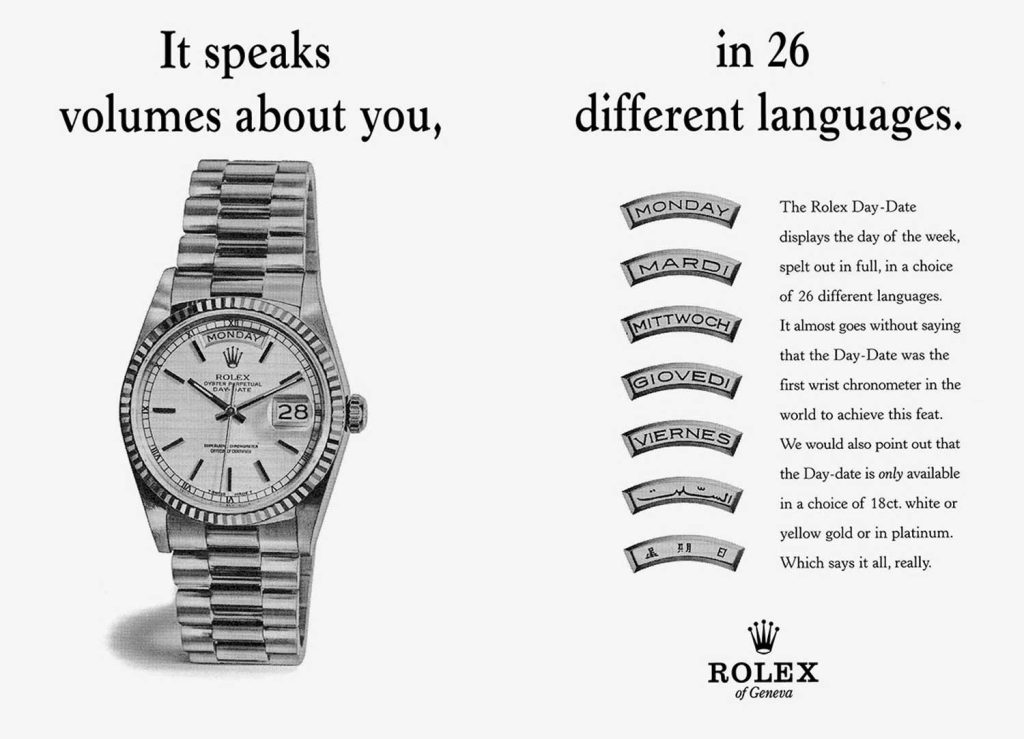
Rolex in different languages
Early Rolex advertisements for the Day-Date show a pair of impressively dressed guards standing outside a pair of closed stately doors. The ads refer to the type of men who wore the model. “You know their faces from a thousand newspaper photographs… You have seen them and heard their voices on newsreels and on your television screen.” Another ad reads: “It costs one thousand dollars to own the Rolex Day-Date, the watch you so often see on the wrists of presidents everywhere.” It was clear from these messages that Rolex was happily unabashed about the intended audience for this timepiece.
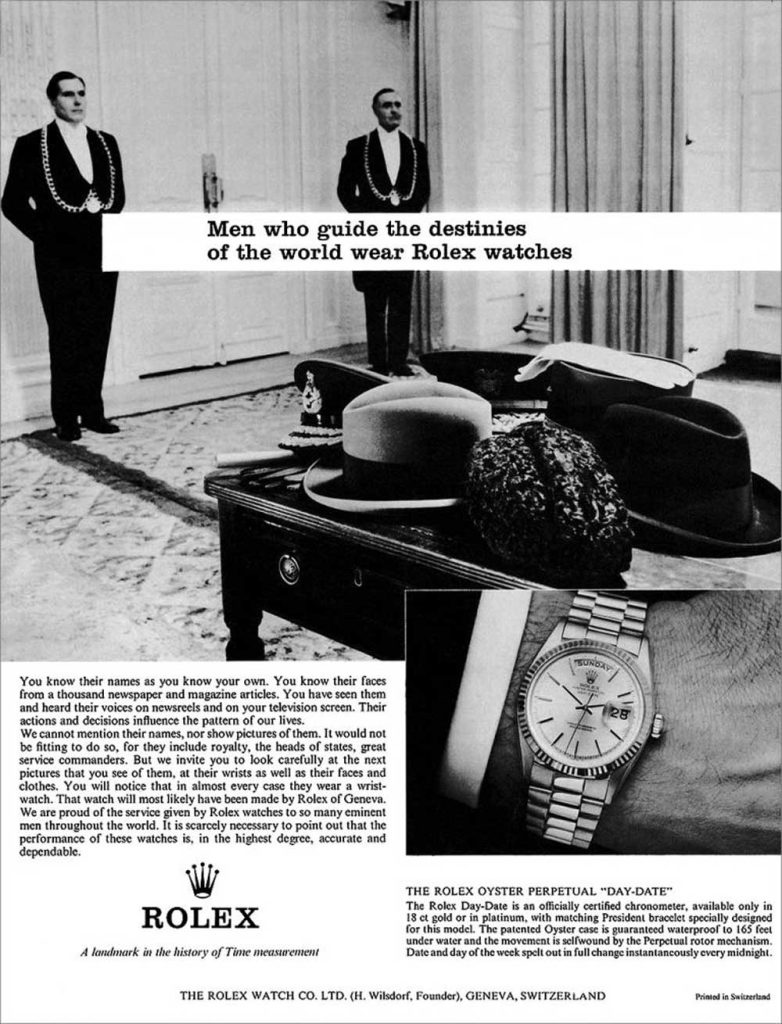
An old advertisement for the Day-Date
Launch of a Legend
The Day-Date – sometimes known as the “President” in collector vernacular, thanks to its adoption as the wrist-swag of choice by Lyndon B. Johnson and, allegedly, John F. Kennedy (the watch apparently having been gifted to him by Marilyn Monroe the same night she sang Happy Birthday to him at Madison Square Garden in 1962, and inscribed, “Jack, with love as always from Marilyn”) – was born in 1956. During its 60-plus years of existence, it has made innumerable cinematic appearances and become a symbol of success, virility, power and alpha-male cool.
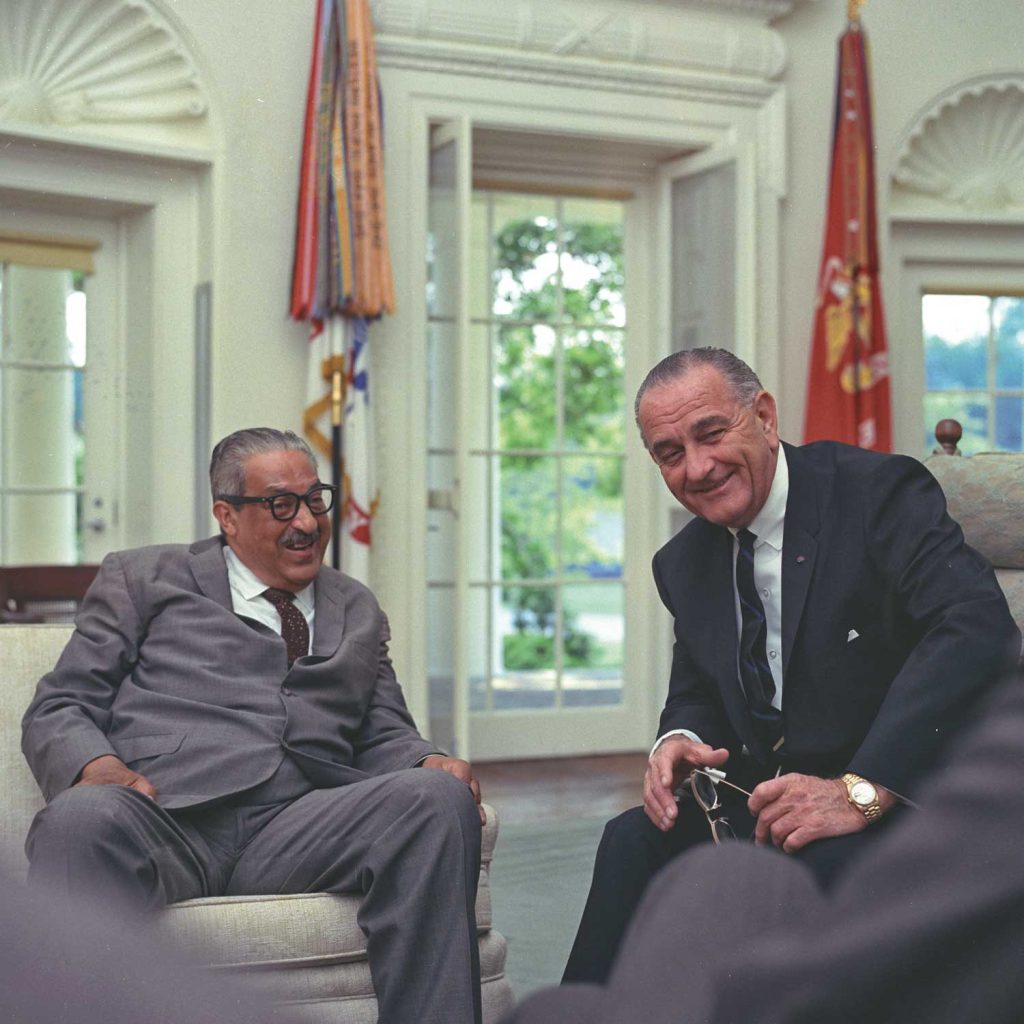
Lyndon B. Johnson was the first US President to wear the Day-Date in office
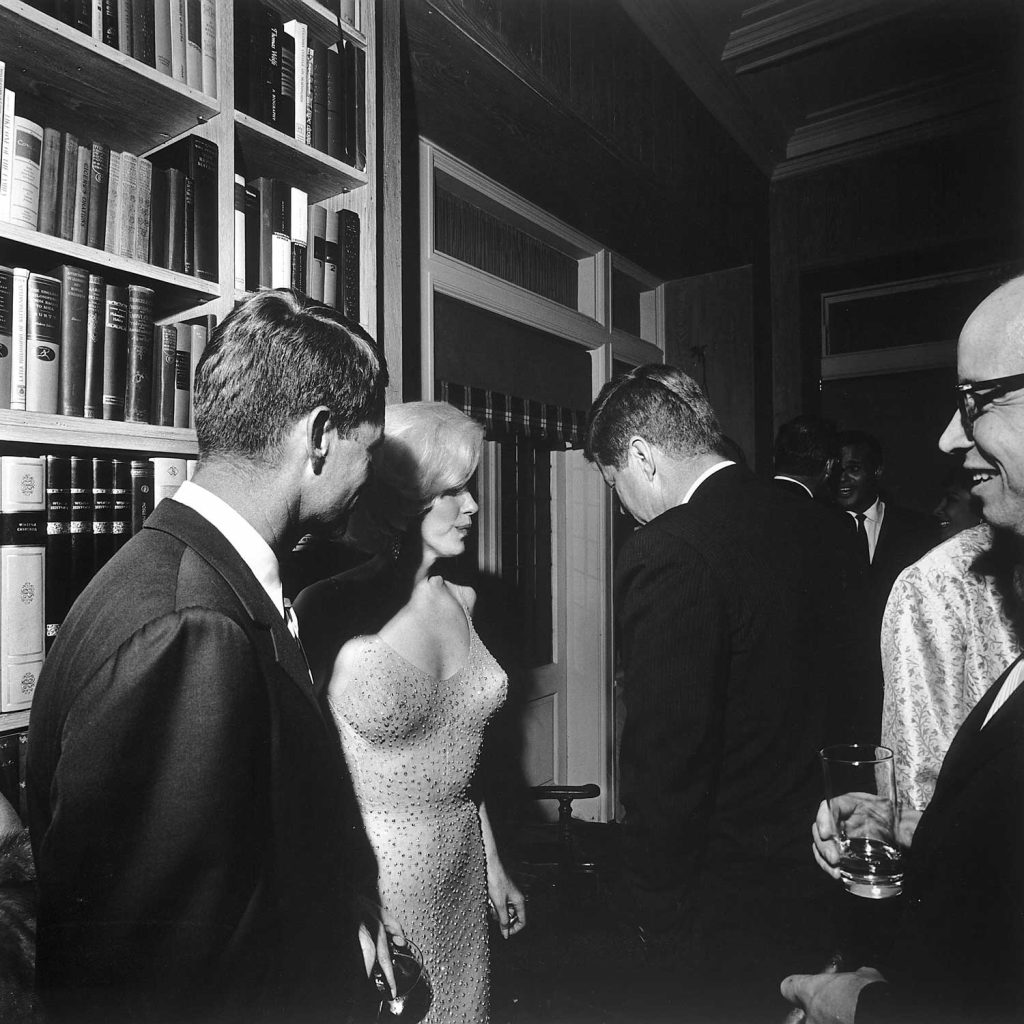
Marilyn Monroe stands between Robert Kennedy (left) and John F. Kennedy at a party in New York, following the democratic fundraiser at Madison Square Garden where Monroe famously sang Happy Birthday to JFK

Alec Baldwin as Blake in Glengarry Glen Ross
But in 1956, Rolex wanted to create something different, a timepiece that asserted its ability in the world of ultra-elegant timepieces. Which, refracted through Rolex’s sensibilities, did not mean a small, dandy’s dress watch but a large (36mm), precious-metal-only chronometer with all its iconic robustness characterised by a screw-down crown, water resistance to 165 feet, and fitted with a precious-metal bracelet. The first references launched were the 6510 and 6511; they lasted only a year before being replaced by refs. 6611, 6612 and 6613, which featured a Calibre 1055 with an all-new free-sprung balance wheel with Microstella regulated screws. This new movement resulted in the watches receiving official certification as chronometers; the dials now read “Superlative Chronometer Officially Certified” (instead of “Officially Certified Chronometer”, as appeared on the 6510 and 6511).
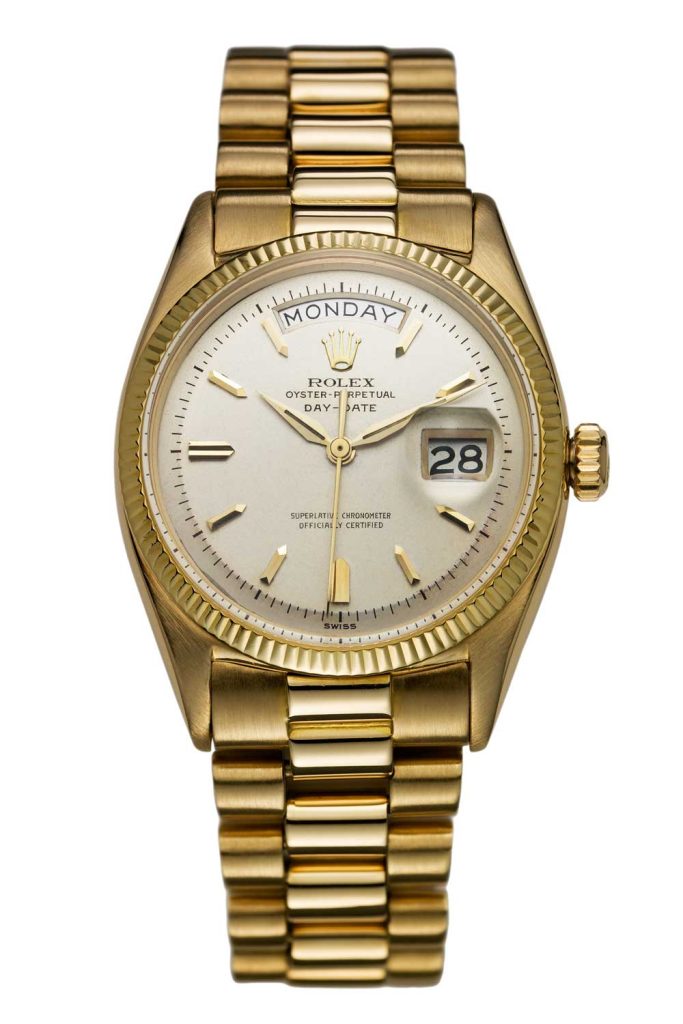
The first model of the Day-Date from 1956
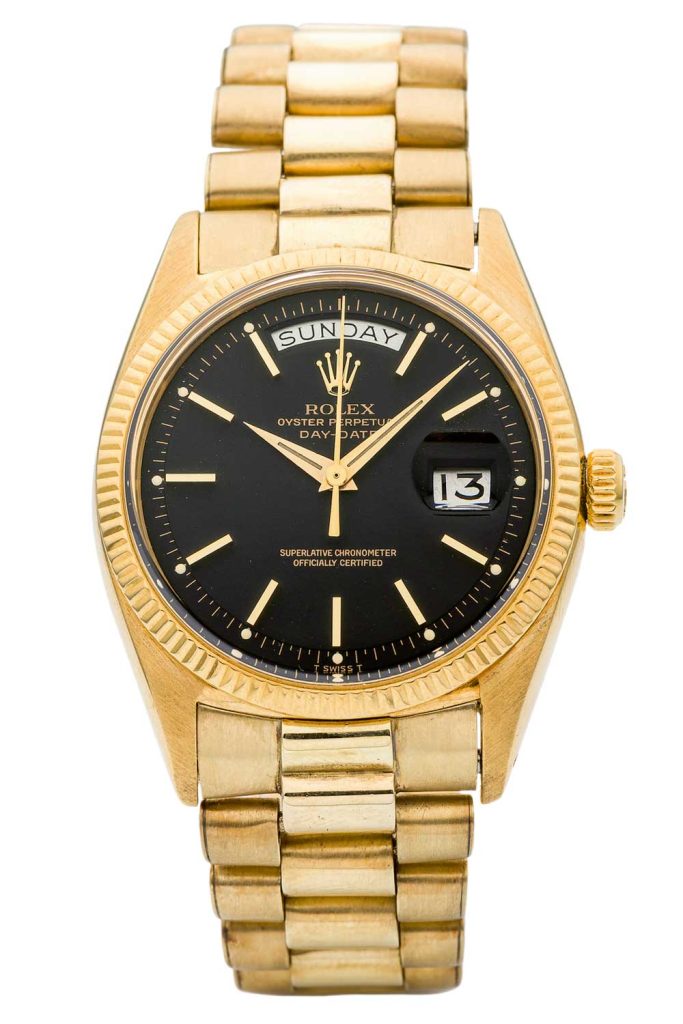
Day-Date ref. 6611
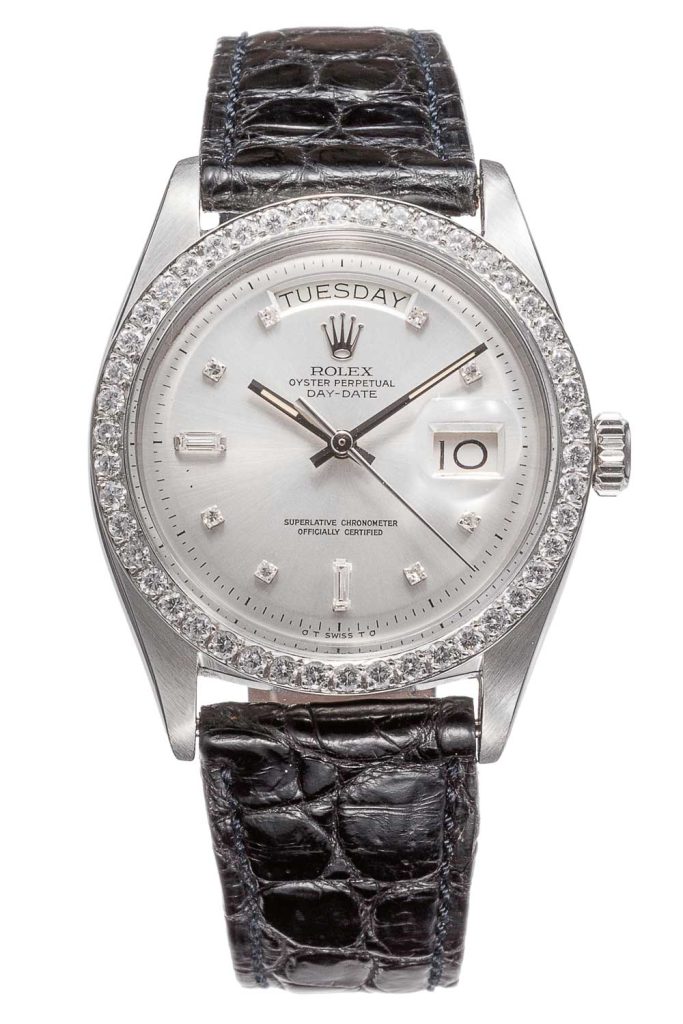
Day-Date ref. 6613
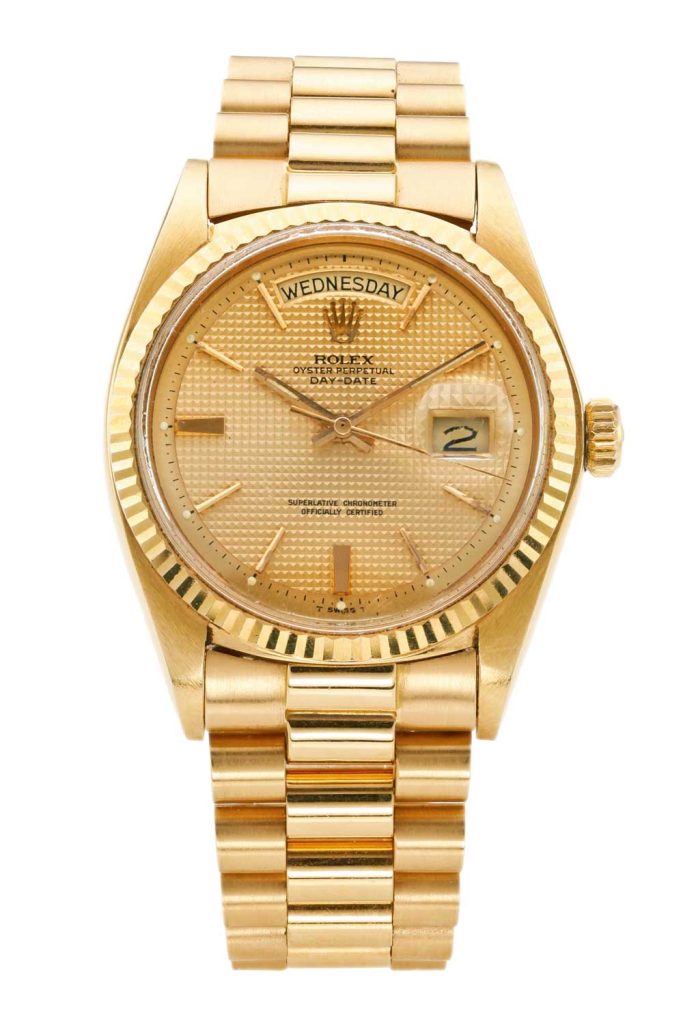
Day-Date ref. 1803 circa 1976
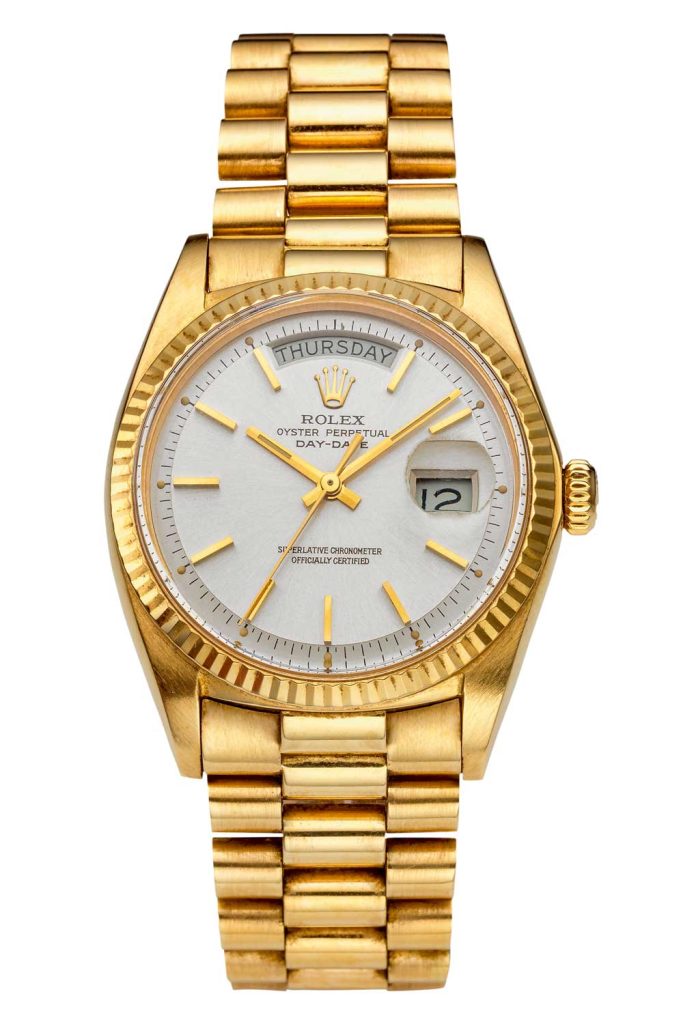
Day-Date ref. 1803
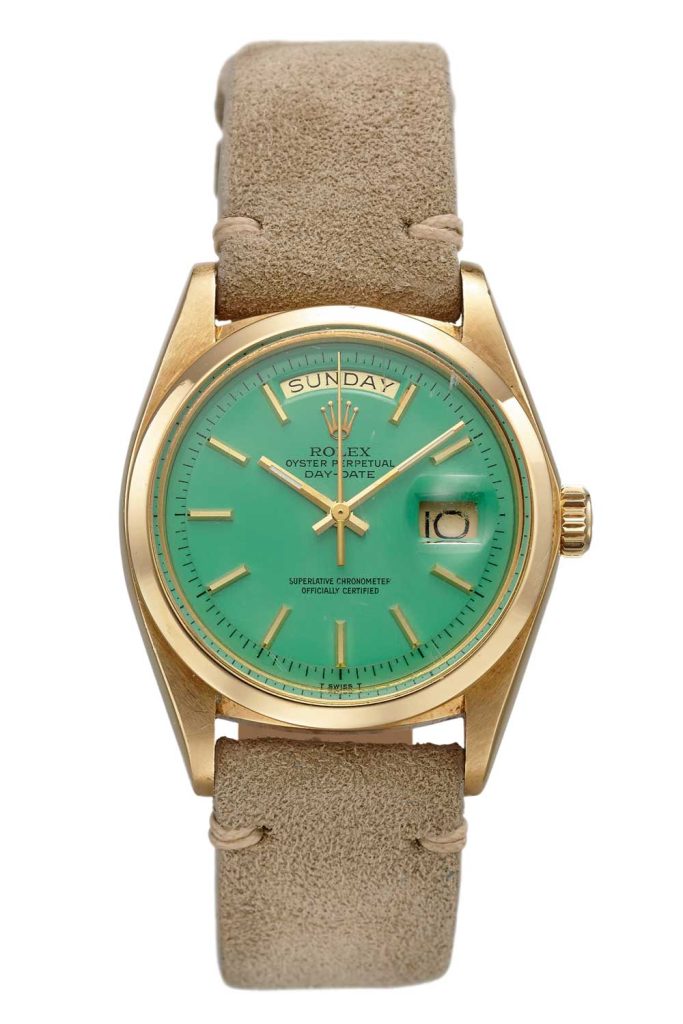
Day-Date ref. 1803 Stella Seafoam Green Dial
Seventies Strides
The 1970s was a period of strong technical advancement for the Day-Date. In 1972, the Calibre 1556 in the Day-Date became equipped with a hacking feature that meant the seconds hand would stop when the crown was pulled out. The watch was also fitted with a sapphire crystal around this time. In 1977, a new Calibre 3055 was fitted to the Day-Date, and the reference numbers for the watches grew by one additional digit: 18xxx.
But the key advantages to the Calibre 3055 were a 4 Hz vibrational speed for better autonomy from micro-shocks, and an all-important quickset function for the date. Before this, the date and days of the week could be adjusted only by turning the central hour and minute hands through the entire calendar cycle.
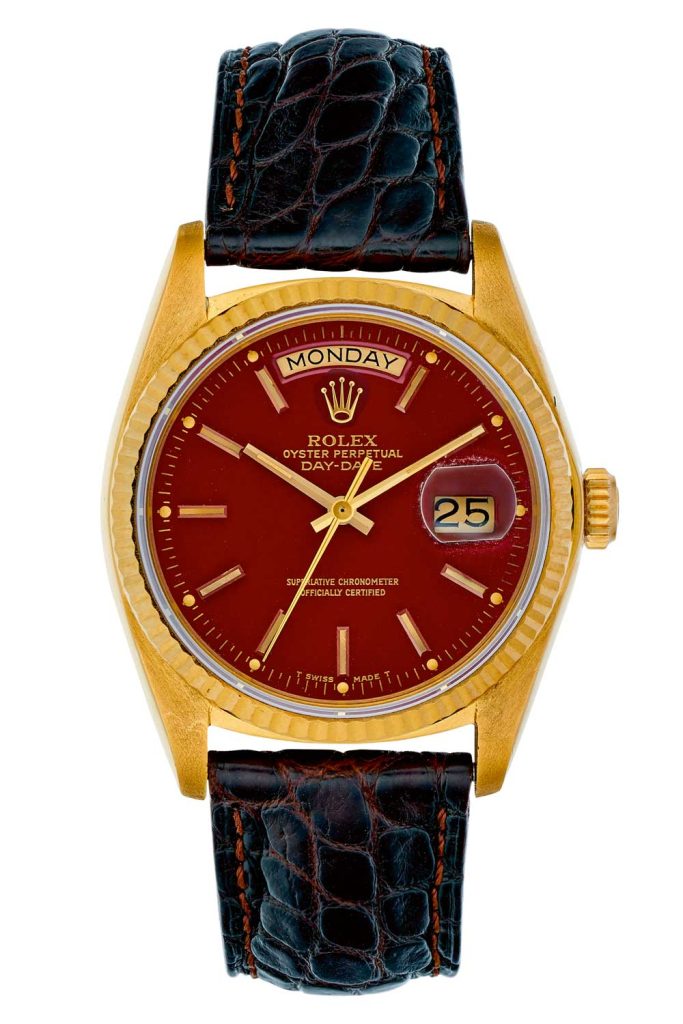
Day-Date ref. 18038 Red Stella Dial
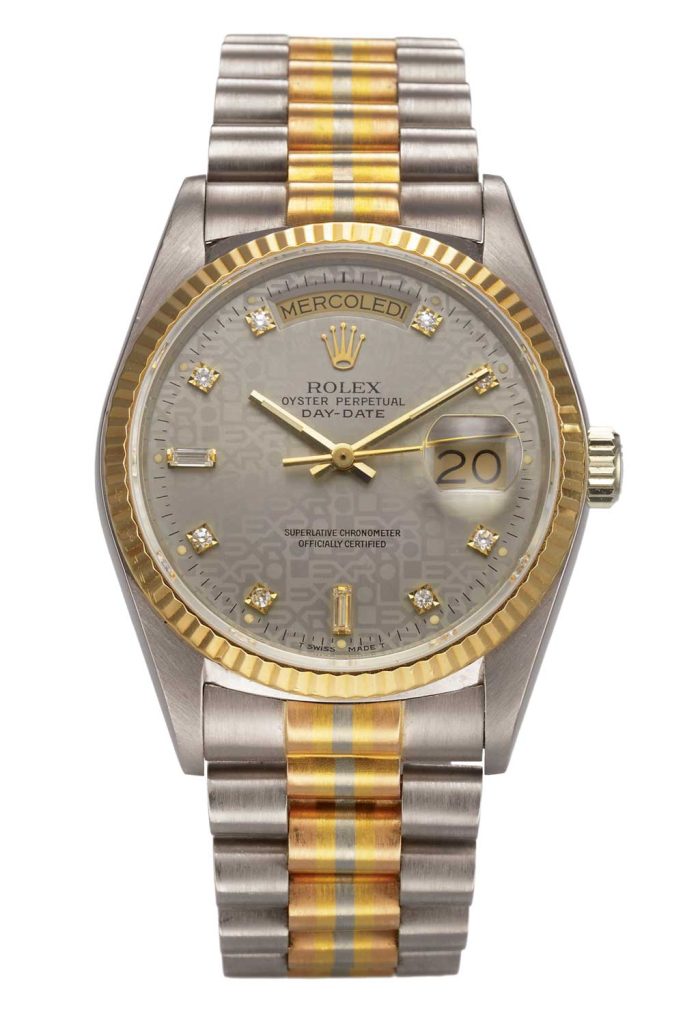
Day-Date ref. 18039 Tridor
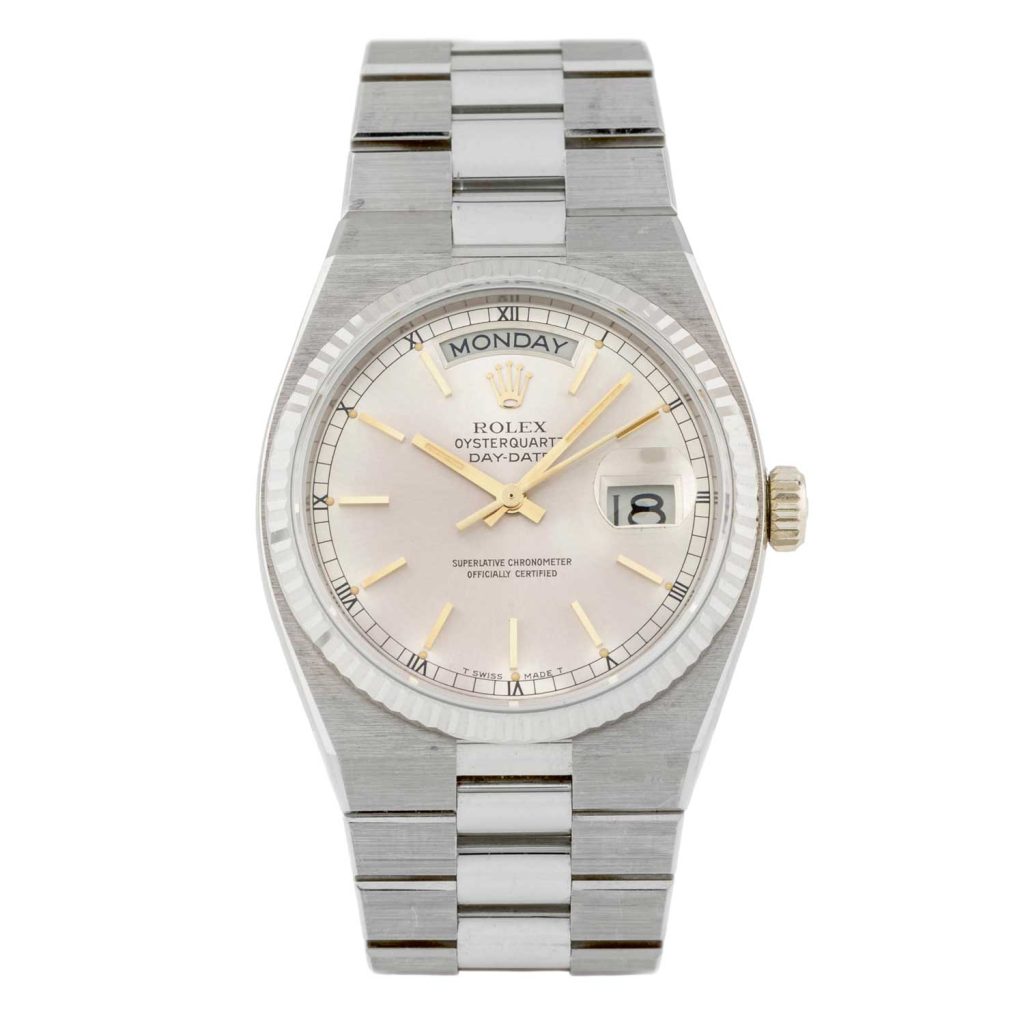
Day-Date ref. 19019 Oysterquartz

Day-Date ref. 18389 Diamond-set
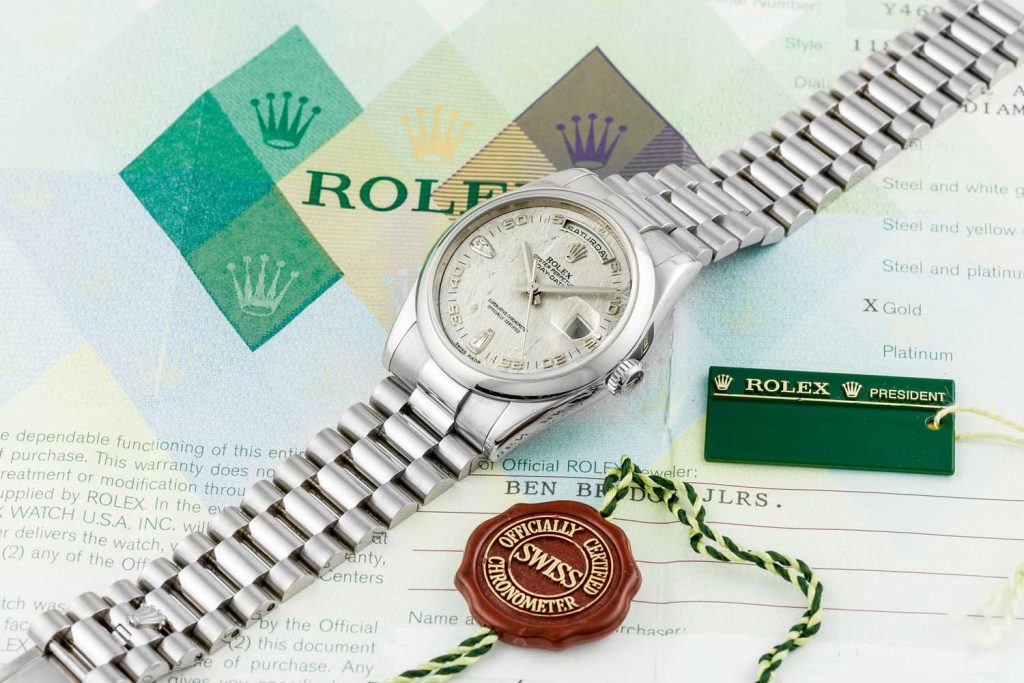
Day-Date ref. 118209
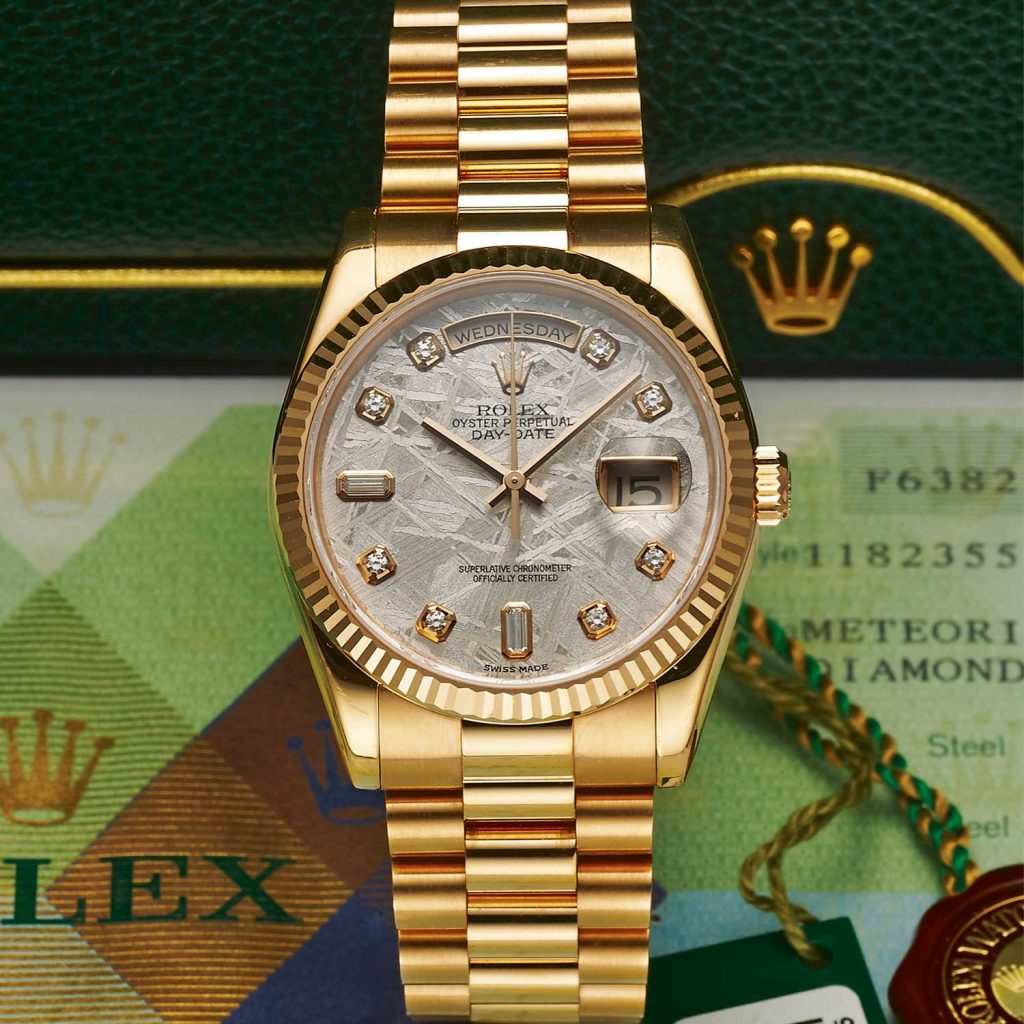
Day-Date ref. 118235
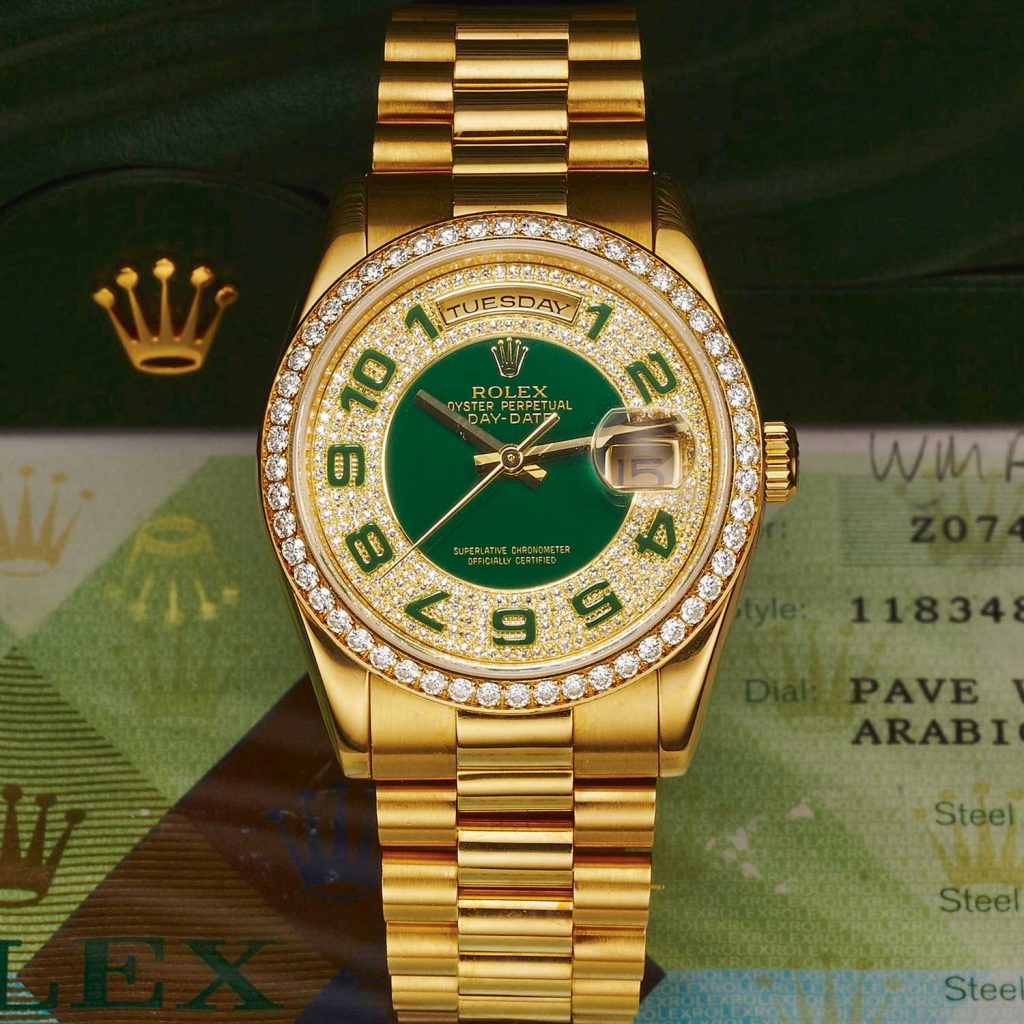
Day-Date ref. 118348
Modern Day-Date
The current collection Day-Date 36 coloured dials were introduced in 2013, and, even though Rolex does not comment on the matter, are clearly a clin d’oeil at the Stella dial Day-Dates, which have achieved cult collectability. These modern Day-Date 36mm watches are each fitted on alligator straps of complementary hues. And for the reader of this magazine, who is unabashedly joyous in his celebration of colour in his sartorial cannon, these charming watches offer infinite chromatic expressive possibilities. It should be noted that one of the world’s ultimate rakes, the style panjandrum Nick Foulkes, wears the 36mm yellow-gold model with antique wood dial with unabashed aplomb.
In 2008 Rolex introduced the Day-Date II, which featured the largest case yet for this model, at 41mm in diameter. The movement in these models was the Calibre 3156. However, in 2015, this model was reduced by one millimetre, to the Day-Date 40mm, and perfectly expresses a greater sense of elegance with a slightly diminished case size.
The modern Rolex Day-Date 40mm is not only a masterpiece of style but its movement, the Calibre 3255, features one of Rolex’s signature technical advancements, the Chronergy escapement. This consists of a pallet and escape wheel made from nickel phosphorus using LIGA technology, which achieves far greater precision than traditional machining or wire erosion. In addition, this material is not affected by magnetism.
The escapement wheel is highly skeletonised, meaning that it is much lighter and has less inertia. This is important because it stops and starts eight times a second, and this lighter weight means 15 per cent greater efficiency. The balance wheel, as with all Rolex watches, is free-sprung, which means that it is adjusted using the weights integrated into the rim instead of changing the tension on the balance spring.
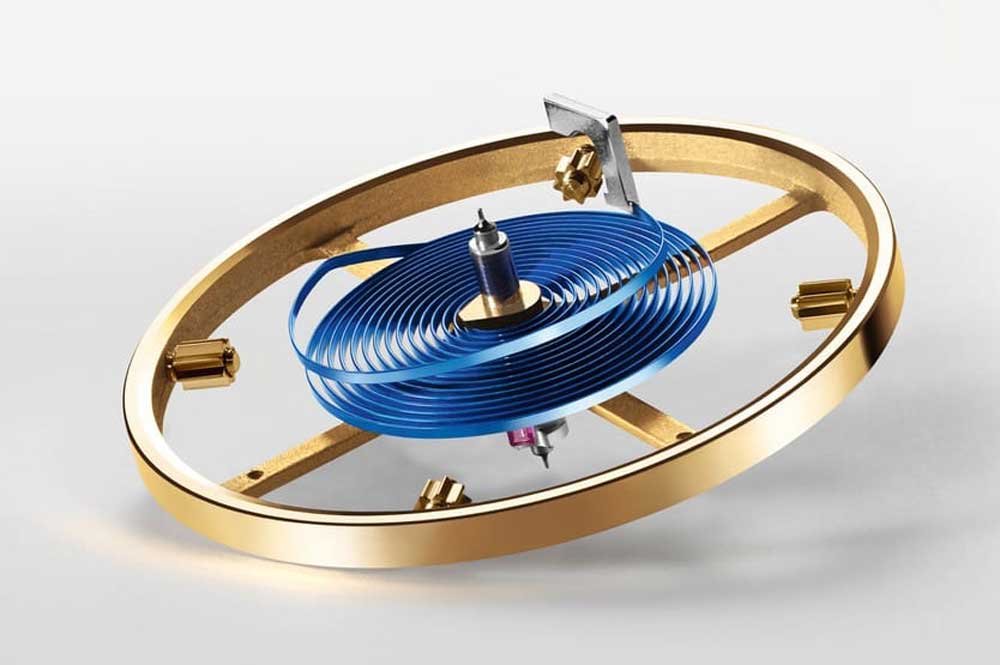
Cal. 3255 free-sprung balance wheel and Parachrom hairspring
My perennial choice for the Day-Date 40mm would be the classic yellow gold with champagne dial, which harks back to the legendary watch Monroe bought for Kennedy and that Baldwin brandished so enthusiastically. The Day-Date is so much more than a watch. It is a symbol of a mental attitude, a lightning rod of empowerment, and a statement of intent that is so clear and resonant that it can be heard the moment you enter a room. No man should feel he is complete without one in his horological arsenal.










